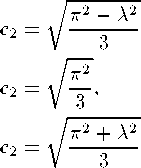Skew Generalized Secant Hyperbolic. A random variable X has a skew generalized
secant hyperbolic distribution with parameters к > 0 and λ > — π is its density is
/ ɪ ʌ ___________Cl___________
∖ 1 + ɪ J a + cosh (c2 κ~ssn(x')χ) ,
where
a = cos(A),
« = 1,
a = cosh(λ)

|
and |
Cl |
sin(λ) = ^Γc2 |
if λ ∈ |
( —7Γ, 0), |
|
and |
Cl |
= C2 |
if λ = |
0, |
|
and |
Cl |
sinh(λ) = ^^C2 |
if λ > |
0. |
The skew logistic distribution is a special case of this distribution when к ψ 1 and
ʌ = 0.
The cdf of X is given by
-P1SGSH («) =
(τ⅛∙) g(kx)
< 1 - fττ⅛) G(-)
у 1+я 2 J V к >
for X < 0,
for X > 0,
where
ɪ + ɪ tan 1 [tan (ʌ) tanh (^-æ)]
G(x) = < 1 [1 ÷ tanh (^-æ)]
ɪ + ɪ tanh 1 [tanh (ʌ) tanh (⅛Jr)]
for λ ∈ ( —7Γ, 0),
for λ = 0,
for λ > 0,
is the cdf of the symmetric generalized secant hyperbolic distribution with zero mean
and unit variance obtained when к = 1. Moreover, the moments of order r, r = 1, 2,...,
are:
E(Xr)
c1 Γ(r + 1)
2⅛+1√α2 - 1


where Lr (∙) indicates the polylogarithmic function whose primary definition is1

Iw∣ <1, w ∈ (D.
Skew Power Exponential. A random variable X has a skew exponential power
distribution (SEP) with parameters к > 0 and β > 0 is its density is
Jsep (^) = (ɪ) r = r °2 ɑə '' eχP [~cβκ 2-sr",∙''i∣.∕∙∣2-] ,
with c = Γ J Γ 1 ɪhe skew Laplace distribution is a special case of the SEP
when к ≠ 1 and β = ɪ. Likewise, when β = 1 we obtain a normal distribution.
1See at the web page http://functions.wolfram.com/10.08.02.0001.01
More intriguing information
1. Macro-regional evaluation of the Structural Funds using the HERMIN modelling framework2. Innovation Policy and the Economy, Volume 11
3. The name is absent
4. The name is absent
5. Language discrimination by human newborns and by cotton-top tamarin monkeys
6. Healthy state, worried workers: North Carolina in the world economy
7. Empirically Analyzing the Impacts of U.S. Export Credit Programs on U.S. Agricultural Export Competitiveness
8. THE WELFARE EFFECTS OF CONSUMING A CANCER PREVENTION DIET
9. The name is absent
10. Are class size differences related to pupils’ educational progress and classroom processes? Findings from the Institute of Education Class Size Study of children aged 5-7 Years